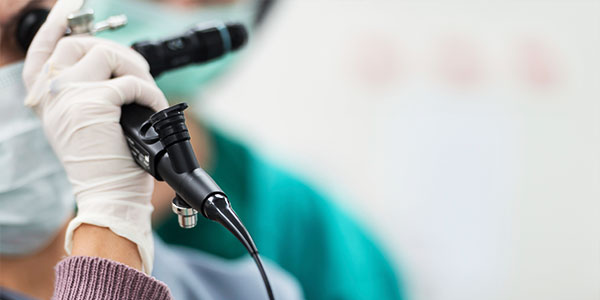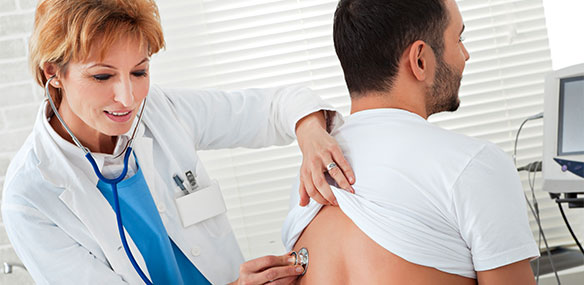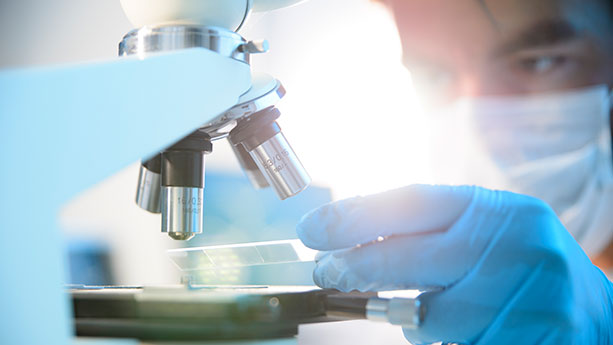It can be scary to learn there’s something preventing your lungs from working correctly, but the interventional pulmonologists at California Pacific Medical Center (CPMC) can help. We use minimally invasive endoscopic techniques to diagnose respiratory disorders and treat a wide range of pulmonary conditions, including lung cancer.
We perform procedures for a variety of lung disorders, including:
- Asthma
- Benign tumors
- Chronic obstructive pulmonary disease (COPD)
- Coughing up blood
- Emphysema
- Lung cancer
- Pulmonary fibrosis
Many interventional pulmonology procedures target airways, lung lesions or tumors, and are done as outpatient procedures. Here are some of the services we offer:
Airway Opening
Interventional pulmonologists can open narrowed airways using a number of different minimally invasive procedures. An airway stent can open airways obstructed or narrowed by infection, tumors or scar tissue.
Balloon dilation is another option and similar to an angioplasty. In this procedure, doctors use a balloon to open an airway. Depending on the location of the narrowed airway, they can also perform a dilation using a bronchoscope, usually in an outpatient setting.

Bronchial Thermoplasty
If you suffer from asthma, bronchial thermoplasty uses radiofrequency energy to heat the muscle walls of your airways and can help lessen your symptoms. CPMC is the only place in San Francisco that offers this service.
Lung Lesion Treatment
We can diagnose and treat lung lesions with image-guided techniques, such as electromagnetic navigational bronchoscopy. We use the SuperDimensionTM system, which gives doctors access to peripheral lung lesions and mediastinal lymph nodes. We might recommend this minimally invasive procedure to patients who have multiple lesions, need a diagnosis before surgery, or cannot tolerate more invasive procedures.
Using ultrasound technologies, we can perform biopsies with greater accuracy. Because this technique allows your pulmonologist to see the needle as it is placed inside the abnormality, it reduces the risk of puncturing a blood vessel. To biopsy lymph nodes in the middle of the chest, we may use an endobronchial ultrasound (EBUS); for peripheral lung lesions, we may use a radial probe ultrasound (REBUS).
Tumor Removal
Some tumors are excellent candidates for radiosurgery, where fiducial markers are placed in or near a tumor, so that radiation can be delivered precisely.
Argon plasma coagulation (APC), electrocautery and laser therapy are other treatment options that can be useful in treating blockages and cancers that cover a large surface area. With these therapies, your pulmonologist uses light or heat from an electric current to destroy tumors, open airways or stop bleeding.
Doctors can also use extreme cold to destroy airway tumors by freezing the tissue through cryotherapy. In this procedure, a probe that has been super-cooled is applied over the surface of the tumor. We can use this treatment in conjunction with others to help obtain tissue for analysis, as well as open up areas of obstruction.
Cryobiopsy
Cryobiopsy is a minimally invasive alternative to surgical methods for collecting lung tissue samples for biopsy. During a cryobiopsy, a surgical instrument called a cryoprobe applies extreme cold to the periphery of the lung, extracting a piece of tissue. Compared to other lung biopsy methods, this technique can collect a larger tissue sample that is better for diagnosing certain lung diseases.
Pleuroscopy
The pleura is the covering surrounding your lungs, and the pleural space is the area between your lungs and your chest wall. Occasionally, this area can be affected by inflammation, infections or cancers, which can lead to symptoms such as chest discomfort, shortness of breath and fluid accumulation in the chest.
Pleuroscopy, also known as medical thoracoscopy, allows doctors to look at the pleura and the pleural space using a small camera. During the procedure, doctors look for abnormalities and take samples of any areas of concern.
They can also use pleuroscopy to guide them through treatments like chest-tube placement and pleurodesis, where they install a glue-like substance in the pleural space to help prevent fluid accumulation.
Pleuoscopy is minimally invasive, and people can often go home the same day of the procedure.
Foreign Body Retrieval
Sometimes, things go down the wrong pipe. When an object falls into the airways of the lung it can cause irritation, cough, infection, bleeding and trauma.
At CPMC we offer a variety of treatment options to remove foreign objects from the airways, including routine bronchoscopy and rigid bronchoscopy. Rigid bronchoscopy utilizes larger tools to assist with trouble-free removal of objects in still a minimally invasive manner, without the need for open surgery.














